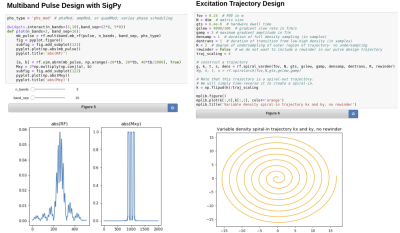Open-Source RF Pulse Design & Demo
Jonathan Bach Martin1 and William Grissom2
1Biomedical Engineering, Vanderbilt University, Nashville, TN, United States, 2Vanderbilt University, United States
1Biomedical Engineering, Vanderbilt University, Nashville, TN, United States, 2Vanderbilt University, United States
Synopsis
The SigPy.RF Python software package provides a comprehensive set of tools for slice-selective, adiabatic, multidimensional and parallel transmit RF pulse design. In this hands-on demo, we introduce SigPy.RF and then show how to use it to design multiband and parallel transmit pulses.
Highlights
- The SigPy.RF Python software package (ISMRM 2020 program number 2814) provides a comprehensive set of tools for slice-selective, adiabatic, multidimensional and parallel transmit RF pulse design.
- The software is part of Frank Ong's SigPy signal and image reconstruction package, and leverages tools such as its advanced optimization and NUFFT methods.
- SigPy.RF is part of the main SigPy package (https://github.com/mikgroup/sigpy), and the bleeding-edge version can be downloaded from https://github.com/jonbmartin/sigpy-rf.
- A library of Jupyter notebook tutorials is maintained at https://github.com/jonbmartin/sigpy-rf-tutorials.
- The software will be demonstrated in a multiband pulse design for simultaneous multislice imaging, and a parallel transmit pulse design for reduced-FOV imaging.
Target Audience
Students and researchers interested in pulse design and sequence development; open-source MRI software users and developers.Outcome & Objectives
In the lecture portion of the course, we will describe SigPy.RF's structure, capabilities and roadmap, and we will walk through the demos. The demo portion will comprise two Jupyter notebooks, one that uses SigPy.RF to design different multiband pulses, and another that uses it to design a spiral parallel transmit pulse. We will also assist with installing the software on attendees' computers. Students will come away from the course understanding SigPy.RF's structure and capabilities, and how to install it and perform basic pulse design tasks.Purpose
MR RF pulse design is an ever-expanding field of increasingly complex methods, especially in parallel transmission, and there is no comprehensive library of these methods. SigPy.RF addresses this need for accessible pulse design for beginners and sequence designers whose main focus is not on developing new algorithms, while also providing a common platform for advanced parallel transmit pulse design method development. We chose to build it into the SigPy image reconstruction and signal processing software because of the many common numerical operations between image reconstruction and pulse design. The purpose of this demo is to introduce SigPy.RF to users, and show how it can be used to design multiband and parallel transmit pulses.Methods
The multiband demo designs both conventional and PINS multiband pulses, and starts with a Shinnar-Le Roux single-band RF pulse design that is then modulated to the multiple slice frequencies. Then the SLR pulse is input to a PINS pulse design. The pulses are Bloch-simulated to verify their slice profiles. The pTx demo designs a spiral pulse using eight transmit channels for reduced-FOV imaging. It begins by designing a k-space trajectory for the desired spatial resolution and acceleration factor. Then the k-space trajectory is used to build a non-Cartesian eight-channel SENSE operator. Off-resonance is optionally incorporated in this operator. Then a conjugate gradient algorithm is invoked to design the pulses. Alternatively, a proximal algorithm can be used for the design which enables constraints on peak RF, SAR, and RF power. Finally, the pulses are Bloch-simulated to verify their excitation profiles.Setup
To participate in the interactive demo portion of the seminar, you will need:- A computer with Python ≥ 3.5 installed.
- The SigPy software package for Python, available through pip (pip install sigpy) or conda (conda install sigpy). Additional information can be found at https://github.com/mikgroup/sigpy.
- The Jupyter notebook software, available through pip (pip install jupyterlab) or conda (conda install -c conda-forge jupyterlab) and ISMRM tutorial notebooks available at https://github.com/jonbmartin/sigpy-rf-tutorials.
